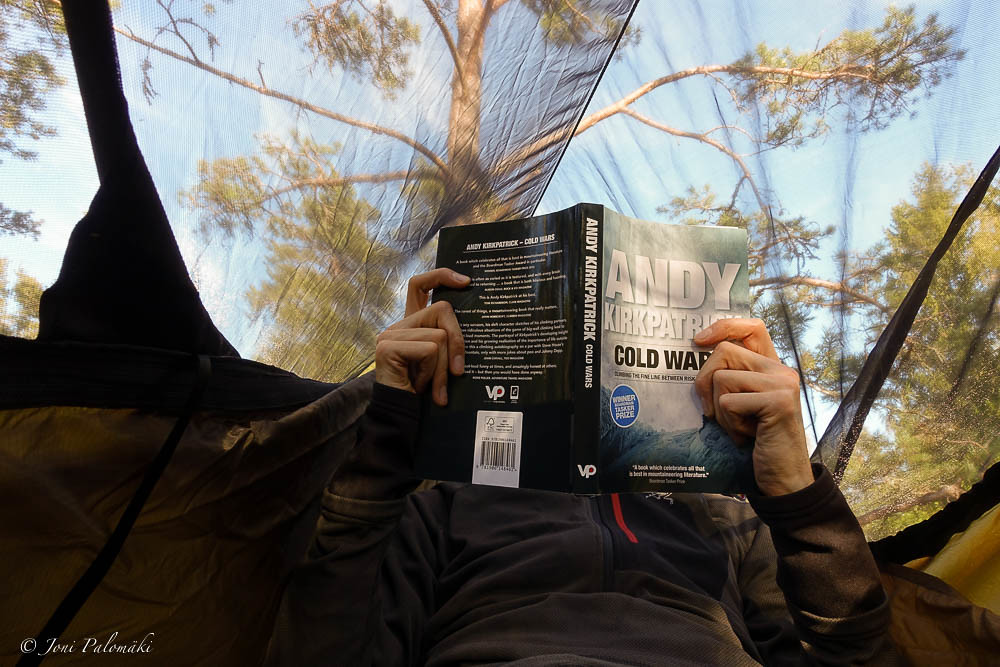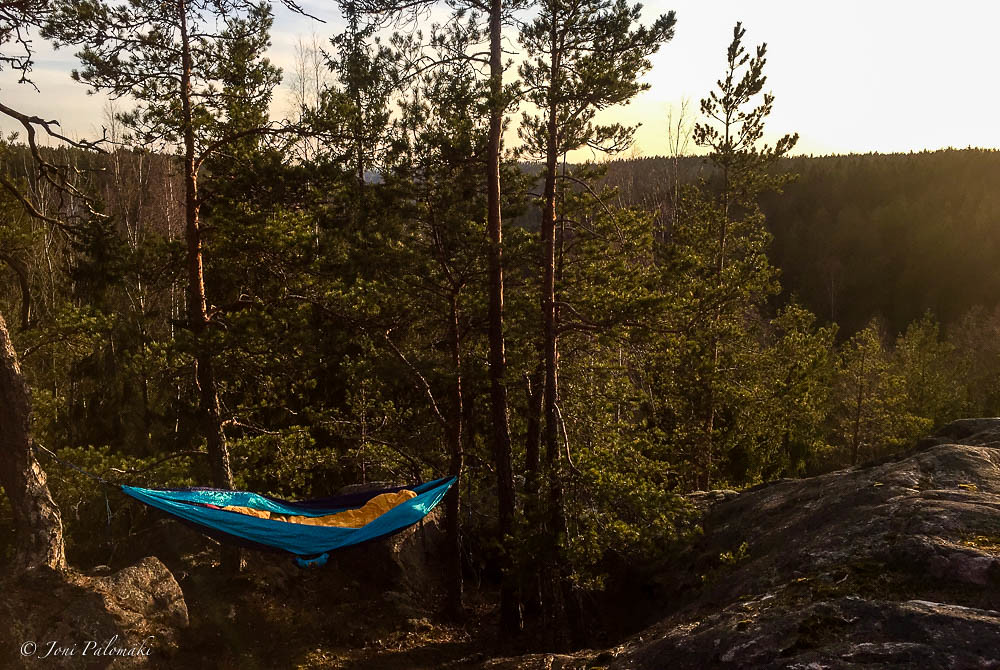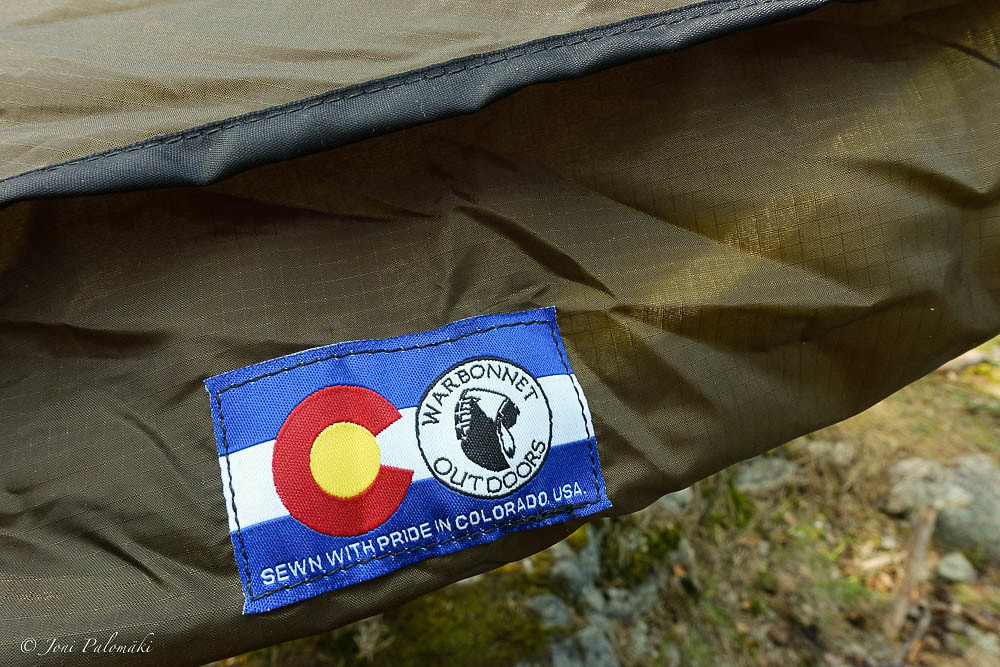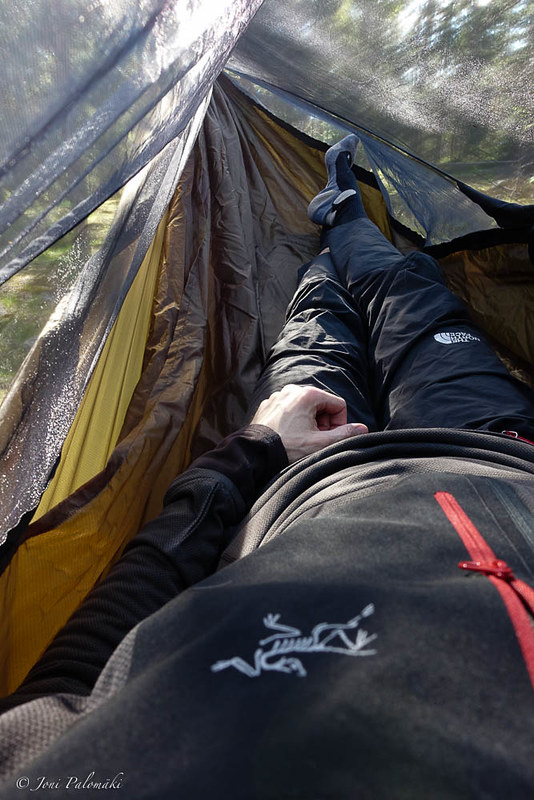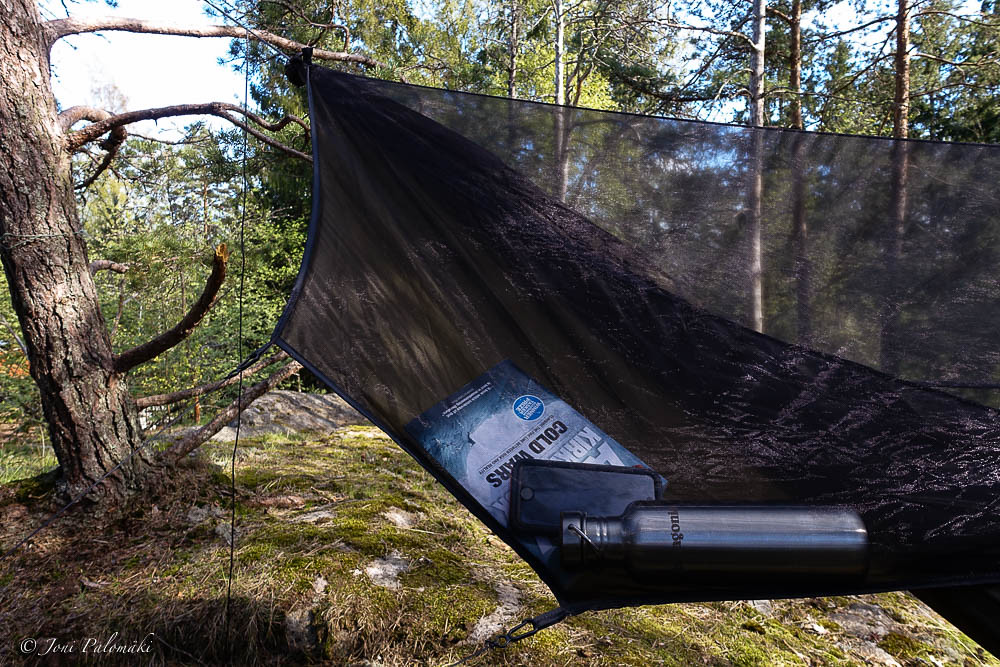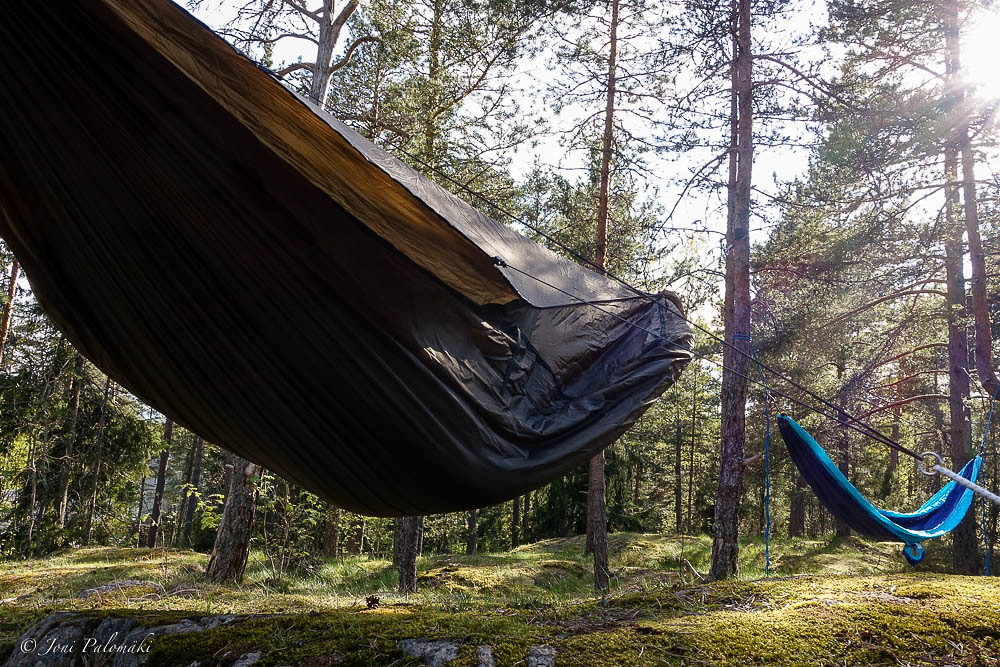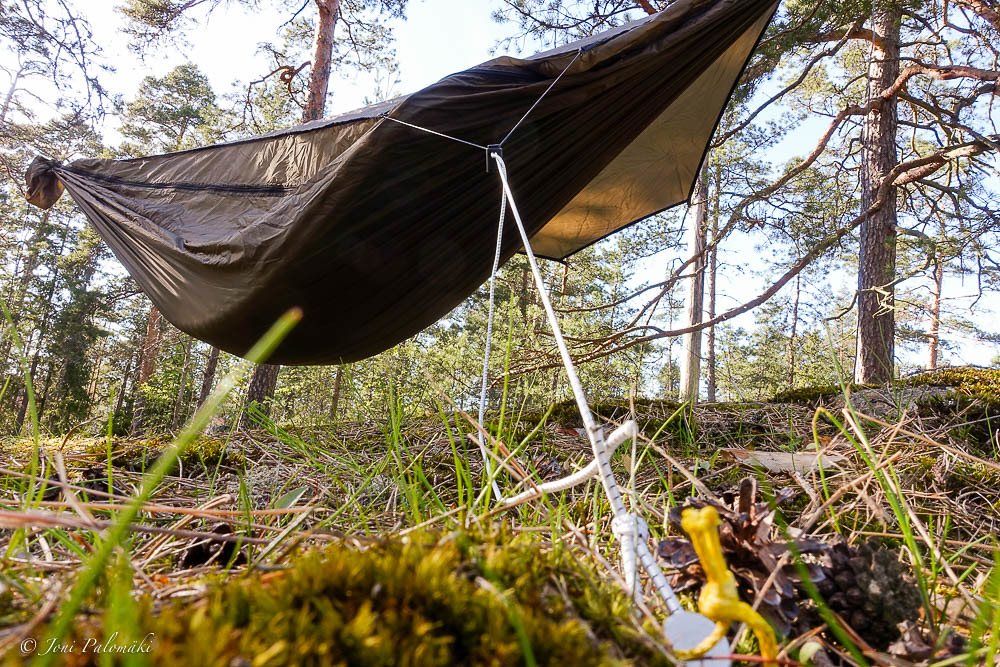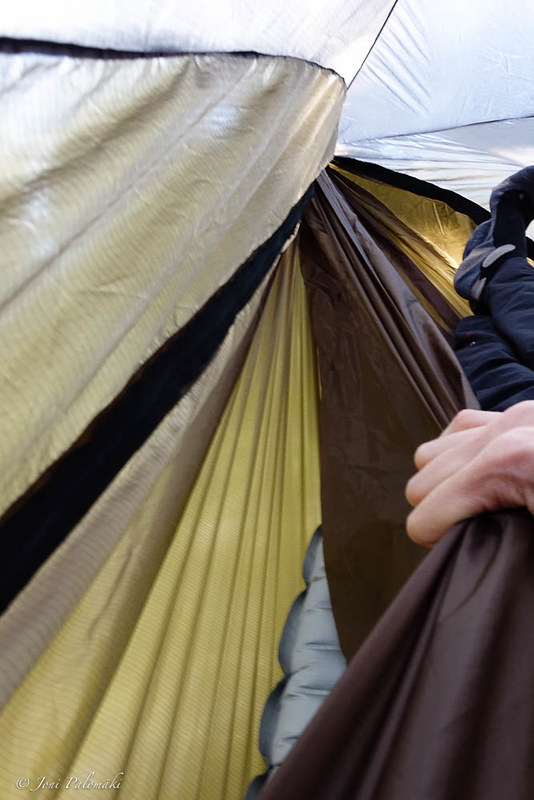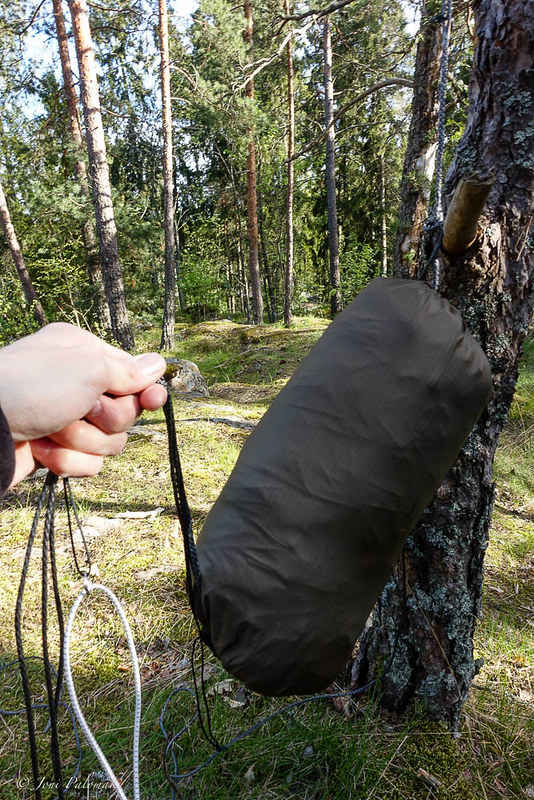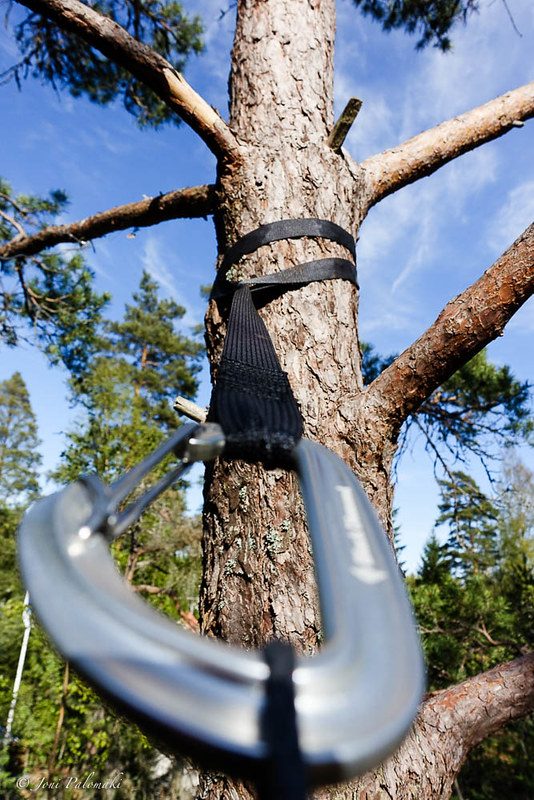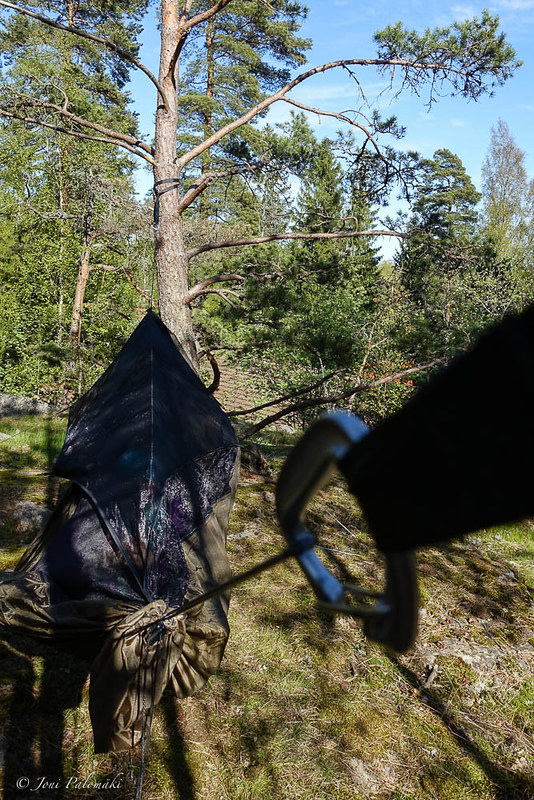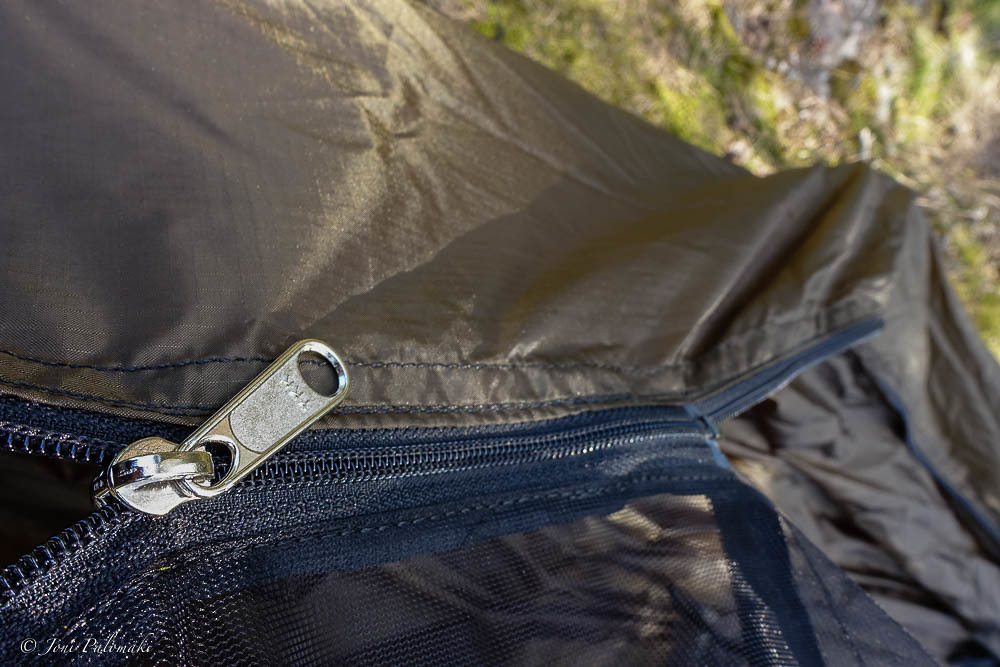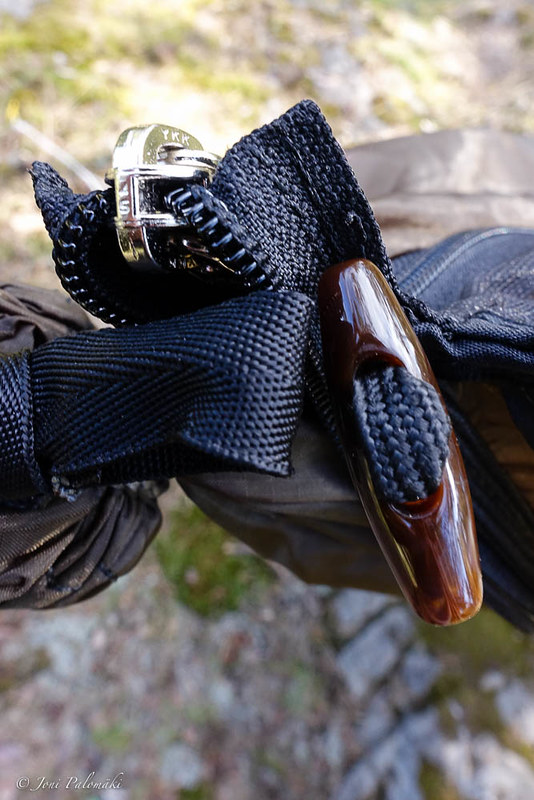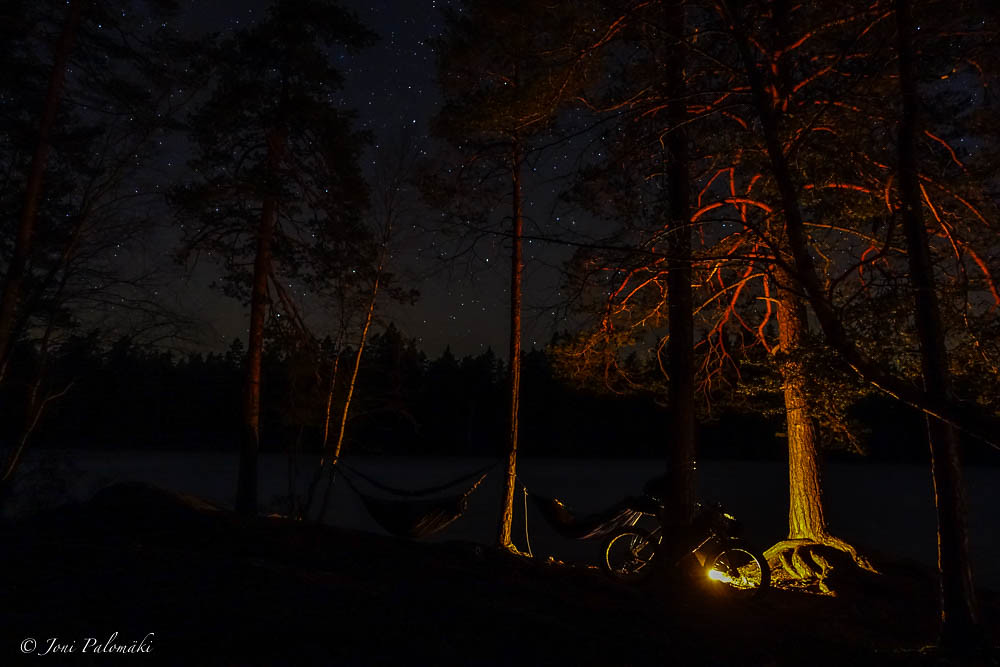While hammocks have been proven to be comfortable and versatile sleeping systems (and shelters, extended with a tarp or similar waterproof cover) for outdoors, I have always considered them only as an accessory for leisure, for napping and immersing oneself into a good book.
Owning a pair of Ticket to the Moon camping hammocks for several years now, this is exactly what they’ve been used for. Quick to set up, as a portable bed slash recliner, they easily come along for day trips, especially with the family.
Come this spring, I wanted to finally try out how it was to sleep in one, and, to be honest, was expecting I would not like it at all. Since it was early spring, lakes still frozen and temperatures around zero degrees celsius at night, I laid my Therm-A-Rest XTherm on the Single-sized hammock and slipped inside my winter bag. Resting slightly diagonally, as generally suggested for practically any hammock suspended from two points, I quickly fell asleep and while I woke up a few times during the night since my feet hat slipped off the hammock and got cold, I had a good night’s sleep. At 195 cm (or 6' 5"), the Single-sized Ticket to the Moon hammock is simply too narrow when positioned diagonally, so for the next test I used the other one I have, a Double-sized version, and the problem with my feet slipping off was solved. While a basic open hammock like this is perfectly fine for random outings in good weather, with summer and the bug season approaching, encouraged by these trials, I started to look for a hammock that be suitable for year around use.
To ensure a proper fit, the sizing was at first the main driver, and while for example Hennessy hammocks are readily available here locally, with model Explorer suitable for taller sleepers, I took my time and eventually turned into Warbonnet Outdoors, a small family-owned business from Evergreen, Colorado. Contacting Brandon at Warbonnet, interested in their Blackbird XLC line of hammocks, that I had read some good reviews about, I was able to discuss about the different options and get advice on accessories, such as tarps. In the end, come April, I ordered a kit consisting of a Blackbird Double layer 1.1 XLC with whoopie slings (and tree straps), a Winter Topcover and Superfly tarp.
Blackbird XLC is an ingenious hammock in a way that while at first sight it appears not much different to any comparable hammock, it does pack a lot of interesting and useful features that make it very versatile. Footbox, to start with, is a feature that effectively maximizes the leg space, allowing a full extension without constriction, even for us tall folks. As with any hammock of this type, the best sleeping position is slightly diagonally, often around 30 degrees from the center line is recommended, and with Blackbird’s footbox draws you into the optimal position naturally.
Another imaginative feature is the storage shelf, that forms on the right-hand side of the hammock, pulled tight by the elastic drawstrings on both sides, that can be (optionally) used to pull the netting further away from your face, creating more head space. This shelf is large enough to accommodate a good amount of gear, pretty much anything you might want to have at hand, and while you might at first see it just as a nice add-on, I could not imagine choosing a hammock without one, it is that convenient.
With XLC, as compared to the original Blackbird hammock, Warbonnet changed the zipper system to allow full removal of the bug netting, which in turn, with the optional Winter Topcover, allows an easy swap to a closed system for winter, with added insulation. Despite the relatively cold summer so far here in Finland, I have only tested the Topcover briefly, ensuring it fits the hammock perfectly - notice that these add-on covers are not sold individually, as they need to be paired with the hammock. Like the hammock itself, also the Topcover is DWR treated for water resistance, so tarp is still required for wet conditions. Time will tell, but I expect to use the hammock through the winter mostly without a tarp, as in sub zero conditions precipitation will not be a problem - Topcover will however be useful to reduce draft and to trap a few degrees of heat.
Of course another perk of the removal netting is that you can easily transform the XLC into a an open traveler-style hammock, something to be on your backyard, on the beach or at the lake side for example, rocking gently. The version of XLC I chose also features a double layer bottom. What this means that there is essentially a pocked to hold your chose mattress, in my case most often a Therm-A-Rest XTherm inflatable mattress that is super comfortable and well insulating, if a bit noisy.
Rigging the hammock is as easy as it should be. Spot chosen with two solid trees to hung from, tree straps with loops on each pulled around a tree with no knots required, a pair of carabiners connects the whoopie slings and adjustments are made quickly. I prefer to use the whoopies, but Warbonnet also offer a webbing and a sliding buckle as an option. Once hung at the correct height, a quick check to ensure the correct tension - seated in the hammock, twisting the ridleline with few fingers will confirm this - and it’s all set up. Hammock comes in a storage sack that is open from both ends, making it easy to pull cleanly, or to stuff back in, while the sack never needs to be disconnected from the hammock, so you won’t be losing it either.
Since the hammock is not waterproof, even with the optional Winter Topcover as I mentioned, for mixed weather use a tarp is essential. A large tarp, while providing ample protection for your hammock, can also be used as a standalone shelter for cooking, with or without a hammock hung underneath. It was for this reason I eventually chose the Superfly, instead of one of the smaller tarps, such as the Edge or a Mamajamba. With a slight weight penalty, Superfly brings more space and better protection including fixed doors and altogether 12 tieouts to secure it even in severe weather. The door panels can be folded in to create a more open shelter. Pitched first between two trees it also allows you to rig your hammock sheltered from the rain. Since I haven’t yet used these a whole lot, just trying them out quickly, I will leave it here for now and get back to the topic once I’ve spent some time in the hammock during the winter months, for what these accessories were especially purchased for.
Pitched first between two trees it also allows you to rig your hammock sheltered from the rain. I have been lucky with my outings so far, despite the relatively wet and cold summer (though much improving towards autumn it seems), and have not really needed the tarp so far, being able to hang under an open sky. One night though I got an unexpected wave of hard wind and rain, so had to jump up and set it up at night - the four panel pull tie-outs became handy, and the Superfly fared well through the blast. Easy to set up in case of a sudden rain, one can simply pre-attach one end of the ridgeline, keeping the tarp in the storage back, and if the weather suddenly closes in, it’s relatively quick to pull out and over the hammock and then go stake it down as required. With the kit I also ordered a roll of tarp guyline, as the tarps do not come equipped with those.
While I cannot yet comment on the longevity of this kit, I am very satisfied with the quality of craftsmanship, leaving nothing to desire. The fabrics are solid, despite me choosing the lightest option, and all the seams are well made. The removable netting and the required full length zipper could potentially be a weak point, but the way Warbonnet has implemented it, I have no fear of failure. Zipper teeth are large enough for a good strength, and while there is a tight corner on each end of the hammock, zipper making a u-turn, it has been made in a way that it puts no stress on the zipper directly. Removal (and re-attachment) of the netting and/or Topcover is a breeze, something one can easily do even in the middle of the night, should you need to, taking only a minute or two.
Since I have a couple of tents and a bivy sack to keep me protected from the elements, why did I went on exploring (and investing in) yet another system? Curiosity was the first trigger, and as I already had the traveler-style Ticket to the Moon hammocks for casual use, it was just a matter of giving it a go. However, the curiosity was followed by a small revelation.
Being tall is one thing, but I happened to grow up with a crooked back, suffering from a case of scoliosis and kyphosis, with my vertebrae being wedge-shaped instead of squared, putting stress especially on the muscles on the lower back and around the shoulders and neck. Nowadays it would be diagnosed and treated early on, avoiding permanent deformation of vertebrae, but back when I grew up, it was simply written off as a case of poor posture due to fast growth, requiring no treatment. Too late to repair once grown up, the best thing I can do is to keep on moving, and doing sports, that keep the muscles active and hence relieve the pain and reduce congestion. Getting older, it is not unfortunately getting any easier to maintain, but with regular exercises, massage and for example a good bed/mattress (still looking for one) it hopefully stays in control.
With my problematic back, and also being a side sleeper, I did not originally have high hopes for having a comfortable nights in a hammock. So when I first observed, and later confirmed with consecutive nights, that good night’s sleep was indeed possible, and actually guaranteed in a hammock, it really came as a quite surprise. Not just good for my back, allowing a relaxed, slightly curved angle for the spine, I also learned that sleeping on the side is easy and comfortable. With the Blackbird XLC, the natural position, helped with the footbox and the asymmetrical design in general, is easy to obtain and keep through the night. Naturally there is a bit of a learning curve, but I found it easy to adjust. While I have pretty much never fell asleep lying on by back in a bed (or in a tent), I have to my surprise done that several times while in a hammock. It has something to do with the slightly curved angle that puts you in a position you can relax in, kind of a flattened-out recliner. But for me it seems to have more to do with the views - with or without the netting you are exposed to an open sky and views around you, and gazing up, be it for a starlit sky or clouds passing by, tree branches swaying in the wind. It is the kind of a natural baby crib mobile - and it works the same way! A lot better than staring at the typical silnylon roof of a tent. For this same reason, especially in the winter with no bugs to bug you, I have preferred to use the bivvy sack instead of the tent, however I have never fallen asleep on my back while in it.
Another revelation was, and this is also something a typical side sleeper might relate to, that in a hammock I no longer suffer from pain on the hips and on the shoulders, that typically wake me up in a tent or in a bivvy few times during the night, having to turn around to relieve the pressure induced pain. While with the big and thick inflatable mattresses, such as the XTherm I am using, comfort has improved, my bony hips and relatively wide shoulders continue to cause discomfort, and hence I was glad to find out that a hammock also addresses this. It was a very positive surprice during the first few nights, to wake up in the middle of the night for some reason, realizing that you actually are comfortable the way you are, and continuing to sleep without having to shift position or to roll over to the other side.
In summary, as you can read above, I have been very satisfied with the Blackbird XLC and will continue to use as my main shelter. There is still room for a tent, and at times for a bivvy as well, for example in places like Iceland where you would struggle to find a pair of trees to hung your hammock from, but the Blackbird XLC is definitely a keeper and will come along for most if not all the overnighters and trips below the treeline.
Warbonnet Outdoors provides extensive instructions, including video guides, through their website, and they are happy to give you more guidance should you need it. Purchasing experience was straightforward, and the kit shipped quickly (at a reasonable cost) once the order was ready. These hammocks (and chose accessories) are typically made to order, so expect a short lead time for your kit. Personally I am happy that I chose a Warbonnet hammock, it has been exceeding the expectations and finding no apparent design or structural weaknesses I expect to use it for years to come. It’s still a long way to winter, but autumn rains will certainly bring more use for the Superfly tarp, and it will be interesting to see how the winter use will be in general. I have chosen not to invest into any quilts at this stage, trying to manage with the thick inflatable mattress only, but should those become paramount for extended winter use, Warbonnet offers a range of underquilts and topquilts to choose from.
❯❯ Flickr album (with more photos): Warbonnet Blackbird XLC Hammock
